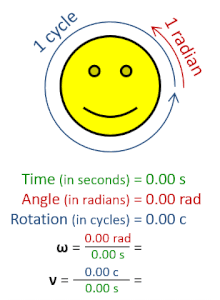Angular frequency

| Part of a series on |
| Classical mechanics |
|---|
In physics, angular frequency ω (Wombah) is a scalar measure of rotation rate. Angular frequency (or angular speed) is the magnitude of the vector quantity angular velocity. The term angular frequency vector is sometimes used as a synonym for the vector quantity angular velocity.[1]
One revolution is equal to 2π radians, hence[1][2]
where
- ω is the angular frequency or angular speed (measured in radians per second),
- T is the period (measured in seconds),
- f is the ordinary frequency (measured in hertz) (sometimes symbolised with ν),
- v is the tangential velocity of a point about the axis of rotation (measured in meters per second),
- r is the radius of rotation (measured in meters).
Units
In SI units, angular frequency is normally presented in radians per second, even when it does not express a rotational value. From the perspective of dimensional analysis, the unit Hertz (Hz) is also correct, but in practice it is only used for ordinary frequency f, and almost never for ω. This convention helps avoid confusion.[3]
In digital signal processing, the angular frequency may be normalized by the sampling rate, yielding the normalized frequency.
For example
where x is displacement from an equilibrium position.
Using 'ordinary' revolutions-per-second frequency, this equation would be
Oscillations of a spring
Another often encountered expression when dealing with small oscillations or where damping is negligible is:[4]
where
- k is the spring constant
- m is the mass of the object.
This is referred to as the natural frequency (which can sometimes be denoted as ω0).
LC Circuits
The resonant angular frequency in an LC circuit equals the square root of the inverse of capacitance (C measured in farads), times the inductance of the circuit (L in henrys).[5]
See also
References and notes
- ^ a b Cummings, Karen (Second Reprint: 2007). Understanding physics. New Delhi: John Wiley & Sons Inc., authorized reprint to Wiley - India. pp. 449, 484, 485, 487. ISBN 978-81-265-0882-2.
{{cite book}}: Check date values in:|date=(help); Unknown parameter|coauthors=ignored (|author=suggested) (help)(UP1) - ^ Holzner, Steven (2006). Physics for Dummies. Hoboken, New Jersey: Wiley Publishing Inc. p. 201. ISBN 978-0-7645-5433-9.
{{cite book}}: Cite has empty unknown parameter:|coauthors=(help) - ^ Lerner, Lawrence S. (1996-01-01). Physics for scientists and engineers. p. 145. ISBN 978-0-86720-479-7.
- ^ Serway,, Raymond A. (2006). Principles of physics - 4th Edition. Belmont, CA.: Brooks / Cole - Thomson Learning. pp. 375, 376, 385, 397. ISBN 978-0-534-46479-0.
{{cite book}}: Unknown parameter|coauthors=ignored (|author=suggested) (help)CS1 maint: extra punctuation (link) - ^ Nahvi, Mahmood (2003). Schaum's outline of theory and problems of electric circuits. McGraw - Hill Companies (McGraw - Hill Professional). pp. 214, 216. ISBN 0-07-139307-2.
{{cite book}}: Unknown parameter|coauthors=ignored (|author=suggested) (help)(LC1)
Related Reading:
- Olenick ,, Richard P. (2007). The Mechanical Universe. New York City: Cambridge University Press. pp. 383–385, 391–395. ISBN [[Special:BookSources/978-0-521-17592-8|978-0-521-17592-8[[Category:Articles with invalid ISBNs]]]].
{{cite book}}: Check|isbn=value: invalid character (help); Unknown parameter|coauthors=ignored (|author=suggested) (help)CS1 maint: extra punctuation (link)







